Cell Cycle and Cell Division Notes NEET Biology - Free PDF Download
The Cell Cycle and Cell Division chapter tells us about the different phases of the cell cycle, and phases of cell division- Interphase and M-Phase. Students will also get to learn about Mitosis and its significance. It is an important chapter in Biology and students preparing for the NEET exam should use the Cell Cycle and Cell Division class 11 notes available on Vedantu.
Using these notes, students will get a complete insight into the chapter and how the cell cycle works. Subject matter experts of Vedantu have articulated notes finely with proper understanding about the chapter carrying simple explanation to each. Students can use these notes while practicing before NEET exam.
Note: 👉Get a Head Start on Your Medical Career with the NEET Rank and College Predictor 2024.
Access NEET 2024 Revision Notes Biology Cell Cycle and Cell Division
Introduction
Cell division is required for growth, repair, and reproduction to occur.
Many cell cycles are required to transform a single cell into a multicellular organism.
Cell Cycle
A cell cycle consists of cell growth, DNA replication, and cell division.
The events that occur during a cell cycle are genetically controlled.
The duration of the cell cycle varies between organisms and cell types. The human cell cycle takes 24 hours on average, whereas a yeast cell finishes one cell cycle in 90 minutes.
Interphase and M-phase are the two stages of the cell cycle.
During interphase, cell growth and DNA replication occur. It accounts for 95% of the time spent in a cell cycle.
Mitosis or M-phase: It is the phase where actual cell division occurs.
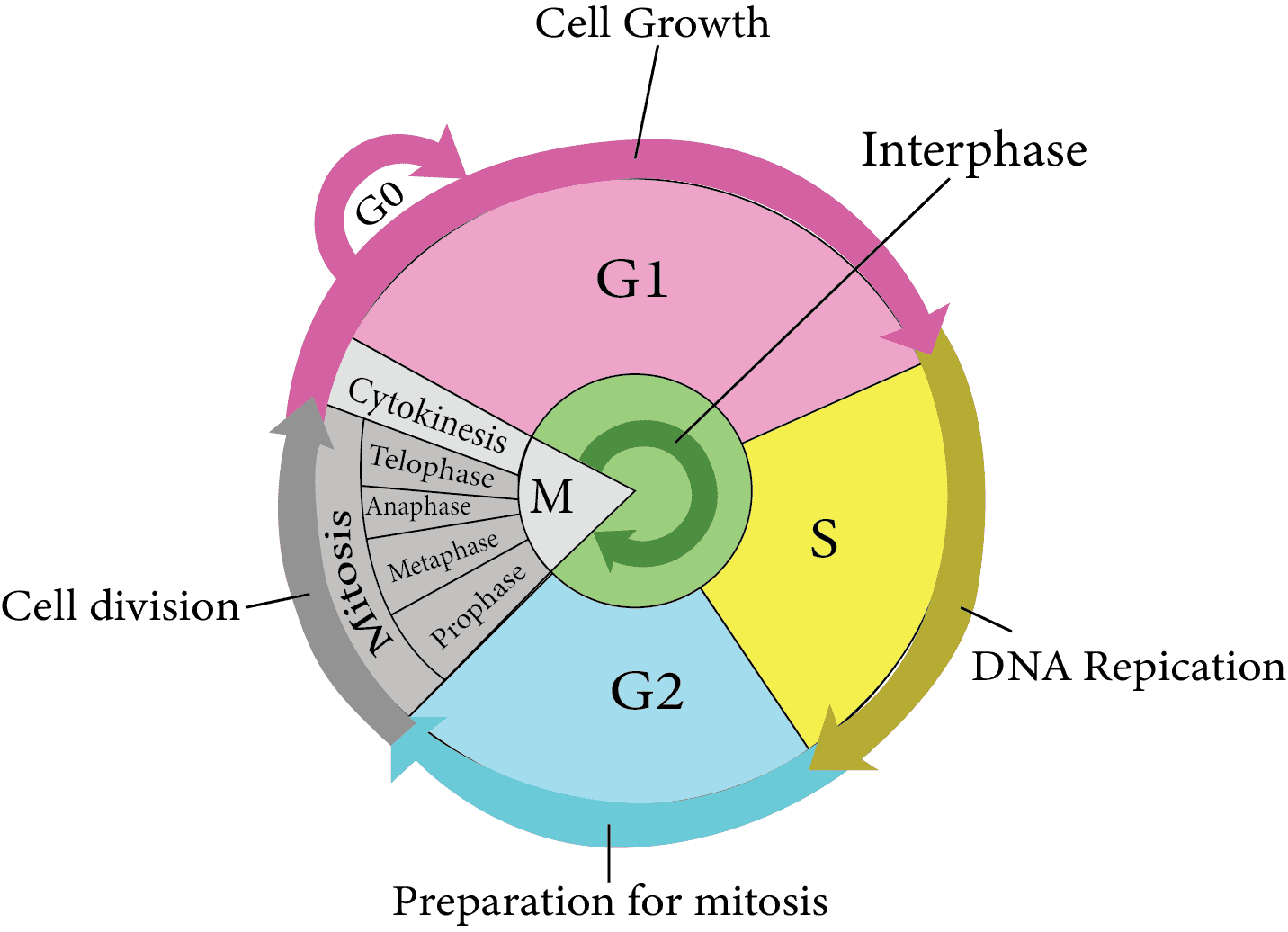
Cell Cycle
Interphase
The interphase period is the time between two sequential M-phases of the cell division.
The cell prepares to divide, grows, and DNA replication occurs.
The interphase is divided into three stages: G1, S, and G2 phases.
G1 Phase or Gap1:
This is the time between the previous mitosis and the next cell cycle's DNA replication.
The cell is biologically active and gets bigger continuously during the G1 phase, but it does not copy its DNA.
Synthesis or S-Phase:
DNA replication occurs during this phase.
The cell's DNA doubles in the amount and the centriole duplicates.
It is worth noting that the number of chromosomes remains constant.
During the S phase of animal cells, replication of DNA starts in the nucleus but the centriole multiplies in the cytoplasm.
G2 Phase or Gap2 Phase:
It occurs when the cell keeps on growing and prepares for mitosis.
Protein synthesis occurs in the Gap2 phase.
Many cells in an adult human being do not divide, for example, heart cells divide only infrequently to substitute injured and dead cells.
These injured/ dead cells enter an inactive stage of the cell cycle known as G0 or the quiescent stage. For example, Nerve cell that enters the quiescent stage and thus cannot divide.
Mitotic Phase/ M-Phase
This is the stage at which actual cell division takes place.
Mitosis (Mitotic Division)
Because the chromosome number in the parent cell and daughter cells remains unchanged, this type of division is also defined as equational division.
Mitosis occurs primarily in diploid somatic cells of animals, with a few exceptions, such as the haploid male drone of honey bees.
Mitosis occurs in both haploid and diploid cells in plants.
Mitosis is in charge of multicellular organisms' genetic continuity, growth, and repair.
In the alimentary canal of humans, the epithelial lining and blood cells are constantly replaced.
Meristematic tissues divide continuously in plants all across their lives. Mitosis is responsible for asexual reproduction or vegetative propagation, in which identical individuals are formed.
Karyokinesis, i.e. division of the nucleus, progresses in four stages:
Prophase
Metaphase
Anaphase
Telophase
Prophase:
Untangling of chromatin and condensation of chromosomes
Two chromatids are visibly attached to the centromere.
Each duplicated centrosome emits microtubules (asters)
Spindle fibres and asters make up the mitotic apparatus.
- The nucleolus, endoplasmic reticulum, Golgi bodies, and nuclear membrane all vanish.
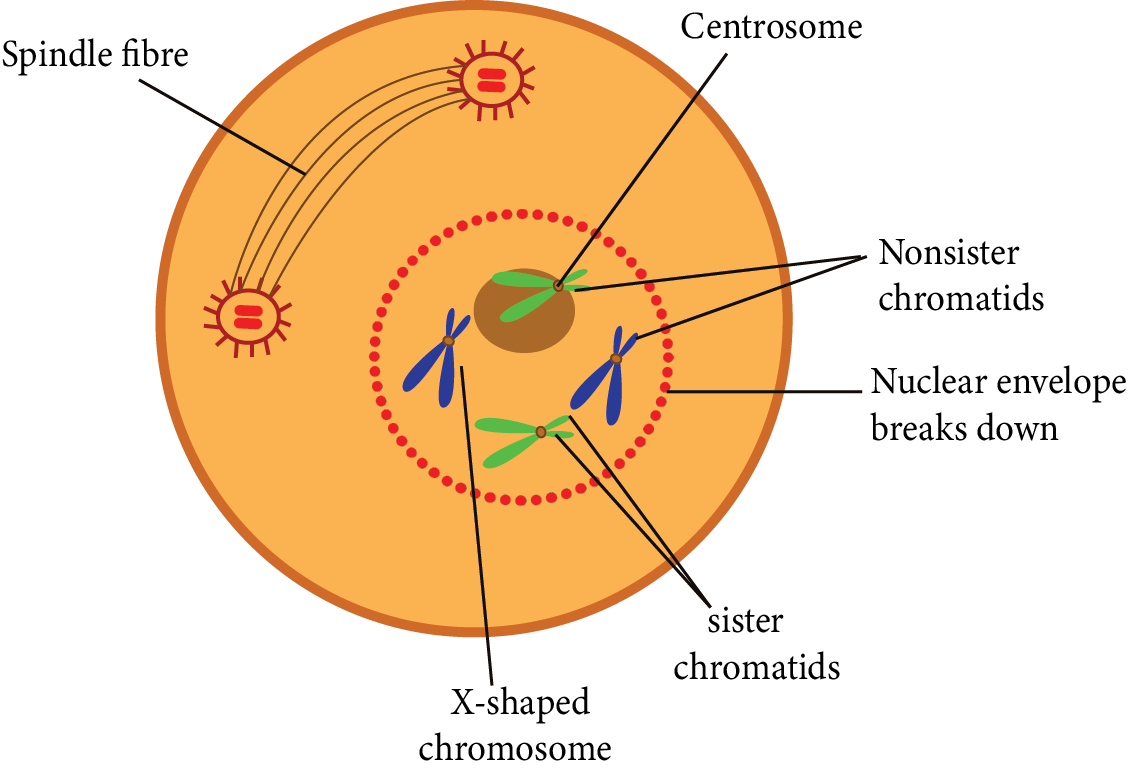
Prophase
Metaphase:
The nuclear envelope has completely disintegrated.
Two sister chromatids are joined by the centromere and positioned at the equator, referred to as the metaphase plate
At kinetochores, each chromatid is connected to spindle fibers from opposite poles.
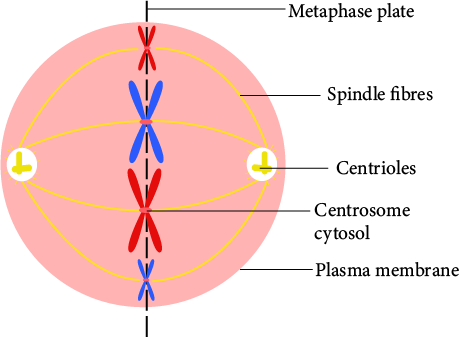
Metaphase
Anaphase:
Centromere splitting occurs, and two sister chromatids disconnect and travel to opposite poles.
Sister chromatids are now known as daughter chromosomes.
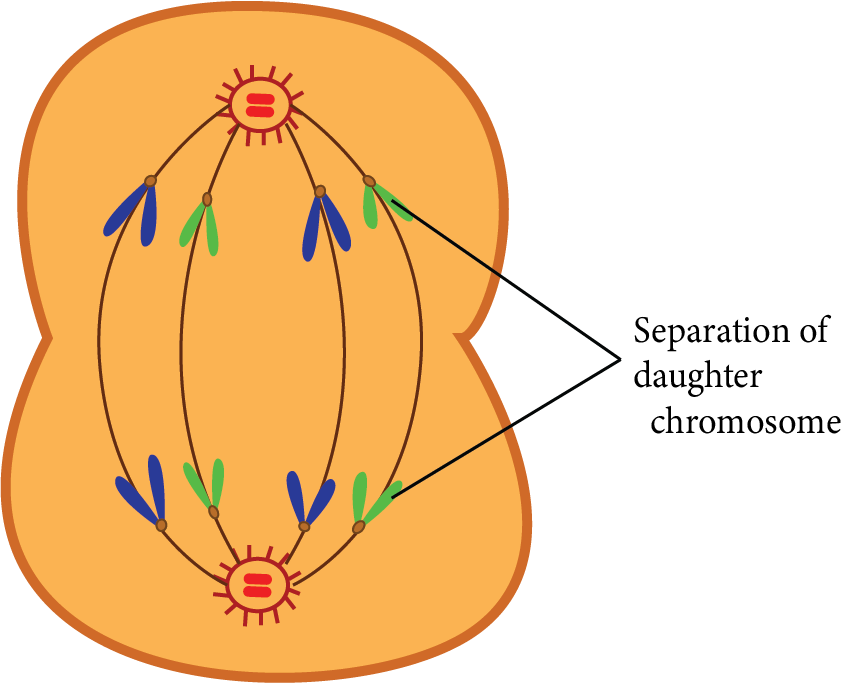
Anaphase
Telophase:
Chromosomes start decondensing when they reach opposite poles.
Each chromosome cluster develops a nuclear envelope, and two daughter nuclei are created.
The nucleolus, endoplasmic reticulum, and Golgi apparatus all reappear.
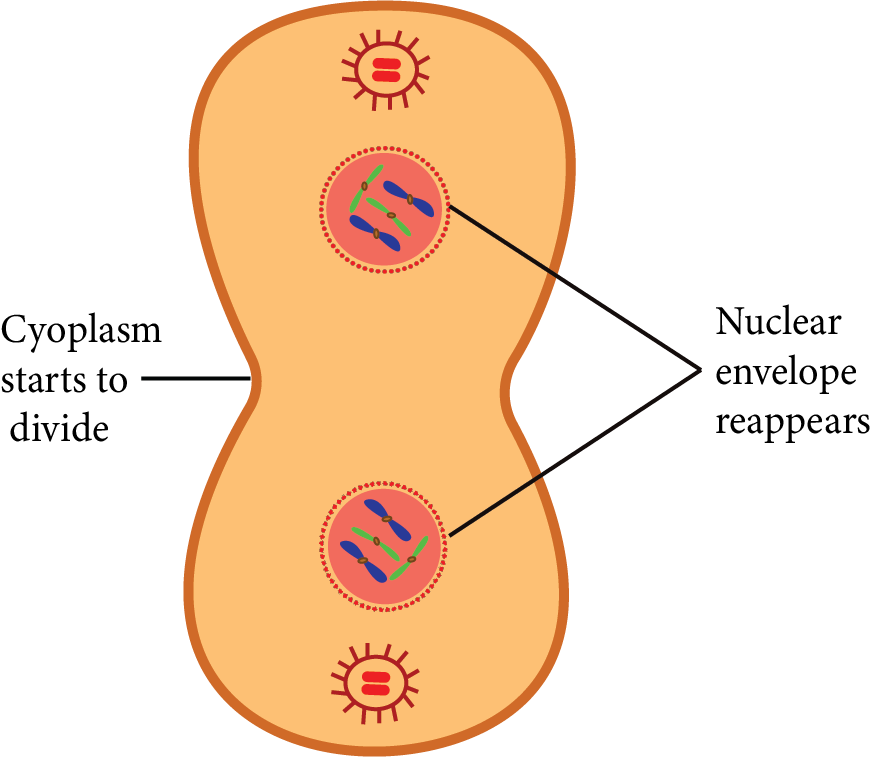
Telophase
Cytokinesis:
The separation of cytoplasm occurs after the formation of two nuclei.
Cell organelles are shared by daughter cells.
In some organisms, such as fungi, algae, and plant cells, cytokinesis is not shortly followed by karyokinesis.
A multinucleate stage is known as a syncytium form, such as liquid endosperm in coconut, Rhizopus coenocytic hyphae, and so on.
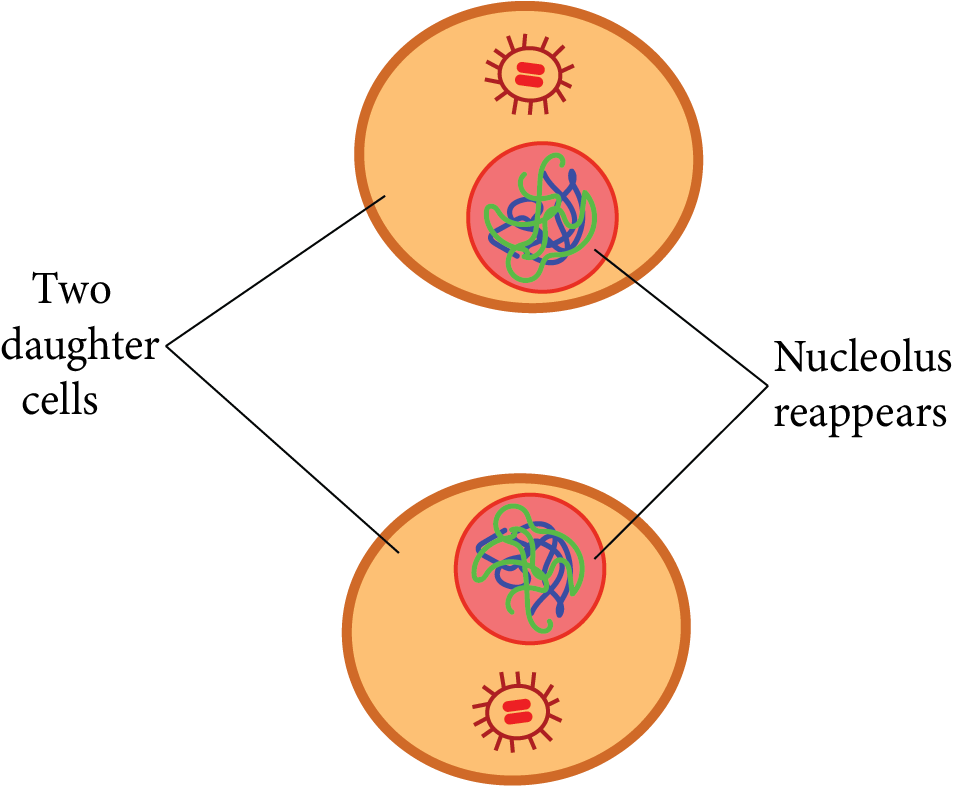
Cytokinesis
Significance of Mitosis:
Mitosis, or equational division, is usually limited to diploid cells.
However, haploid cells divide by mitosis in certain lower plants and social insects.
It is critical to comprehend the importance of this division in an organism's life.
Mitosis typically produces diploid daughter cells with identical genetic material DNA.
Mitosis is the process by which multicellular organisms grow.
The nucleus-cytoplasm ratio is disrupted as a result of cell growth. As a result, cell division is required to revive the nucleo-cytoplasmic ratio.
Mitosis makes an important contribution to cell repair. Cells in the upper epidermal layer, cells in the gut lining, and cells of the blood are constantly replaced.
Mitotic divisions occur in the meristematic tissues like the apical and lateral cambium, resulting in plants growing continuously throughout their lives.
Meiosis (Meiotic Division)
Meiosis is also referred to as reduction division.
Meiosis is responsible for forming haploid gametes during sexual reproduction (gametogenesis).
Meiosis is in charge of preserving the chromosome number in various members of the same species.
Meiosis also explains genetic variation or dissimilarities between two members of the same species.
Meiosis-I and Meiosis-II are the two sequential cell divisions.
In the S-phase occurring before meiosis-I, DNA duplication occurs only once.
The pairing of homologous chromosomes is pursued by recombination or crossing over between non-sister chromatids and the formation of two haploid daughter cells during meiosis-I.
Meiosis-II is similar to mitotic division in that four haploid daughter cells are created at the end of meiosis.
Meiosis-I:
Prophase-I
Prophase-I is a long stage that is further subdivided into several stages:
Leptotene- Chromosomes begin to condensate.
Zygotene- Homologous chromosome pairing. The construction of the synaptonemal complex characterises synapsis. Chromosomes can be bivalent or tetravalent.
Pachytene- Crossing over occurs between non-sister chromatids, resulting in the formation of a recombination nodule. This is an enzyme-mediated reaction. The enzyme in charge of crossing over is Recombinase.
Diplotene- Other than at the crossovers creating Chiasmata (the 'X' shaped structure), the synaptonemal complex dissolves, and homologous chromosomes detach from each other. Some vertebrate oocytes can persist in the diplotene step for many years, such as human primary oocytes until puberty when ovulation occurs. Lampbrush chromosomes are formed in amphibian oocytes at the diplotene step.
Diakinesis- It occurs when the nucleolus disappears, the chiasmata separate, and the nuclear envelope begins to degrade.
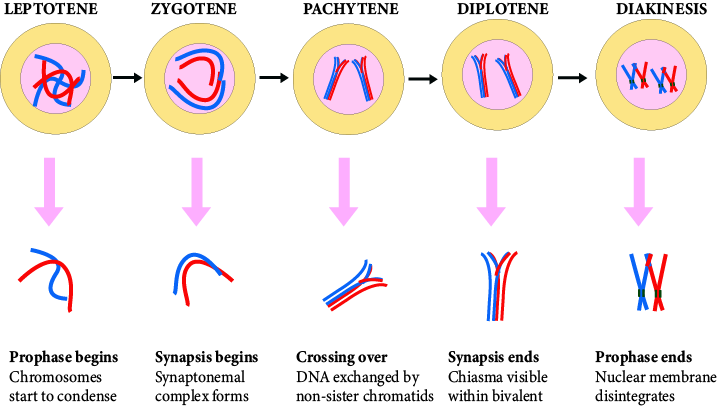
Various stages of Prophase-I of Meiosis in Sequence
Metaphase-I
- Bivalent chromosomes line up at the equator, while homologous chromosomes attach to spindles from opposing poles.
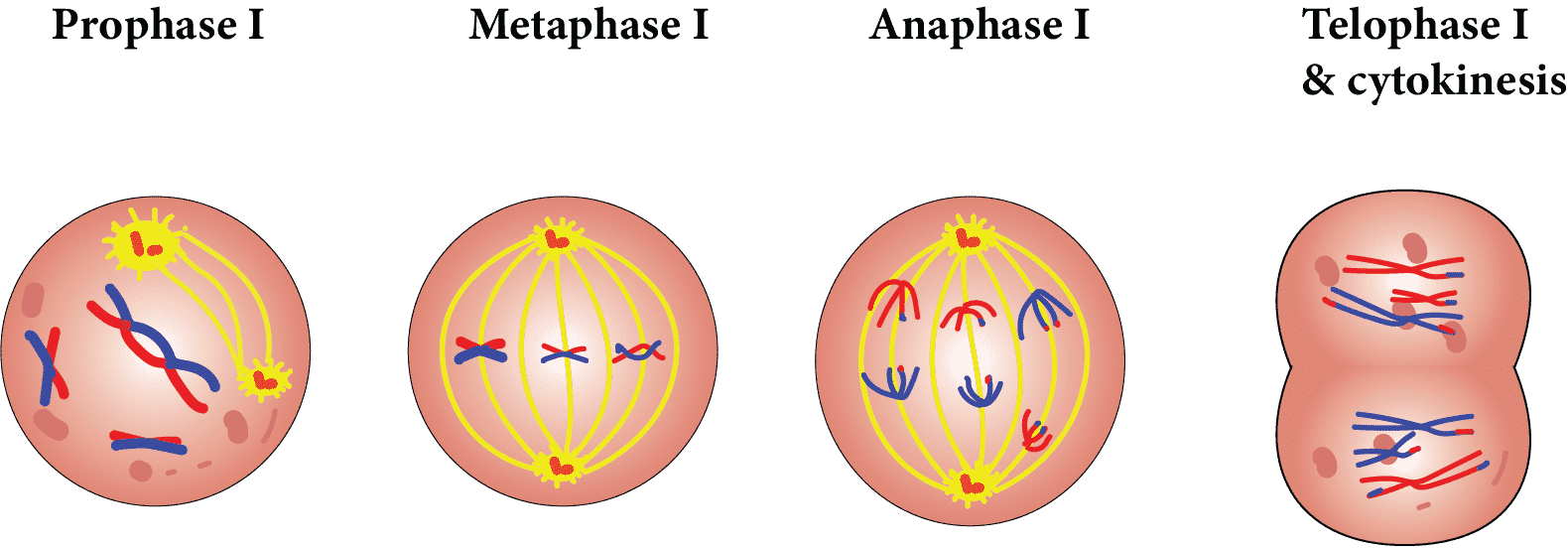
Meiosis- I
Anaphase-I
Homologous chromosomes shift to the opposite poles.
In contrast to mitosis, sister chromatids in meiosis stay connected.
Telophase-I
The nucleolus and nuclear envelope reappear, and the chromosomes congregate at the poles.
This is pursued by cytokinesis and the formation of haploid dyads.
Meiosis-II
Meiosis-I is pursued by a short period of interkinesis. At this point, there is no DNA replication.
Meiosis-II is much more like mitosis, with each haploid cell forming two more haploid cells, resulting in four haploid cells from a single diploid cell after both meiotic divisions.
Prophase-II
The nuclear envelope vanishes.
Metaphase-II
Chromosomes align at the metaphase plate, and sister chromatid kinetochores attach to spindles from opposing sides.
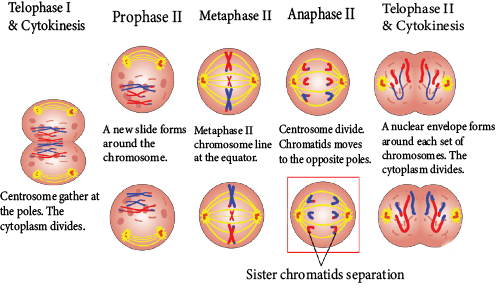
Meiosis II
Anaphase-II
Sister chromatids separate and centromeres split. They travel to opposing poles.
Telophase-II
The nuclear membrane resurfaces.
Cytokinesis then occurs, resulting in four haploid daughter cells, or tetrads.
Differences Between Meiosis-I And Meiosis-Ii are Given Below in the Table:
Meiosis I | Meiosis II |
The chromosomes are arranged at the cell's equator in homologous pairs. | Chromosomes line up at the equator of the cell individually. |
Whole chromosomes move to opposite poles of the cell. | Daughter chromosomes/chromatids move to opposite poles of the cell. |
Two cells form at the end of this division. | Four cells are formed at the end of this division. |
The chromosome number is halved during meiosis I. | The chromosome number remains the same during meiosis II. |
Crossing over takes place. | Crossing over does not take place. |
Significance of Meiosis:
Meiosis is the mechanism by which specific chromosome numbers of each species are conserved across generations in organisms that reproduce sexually, although the process itself paradoxically results in a halving of chromosome numbers.
It also increases genetic variability in organism populations from one generation to the next.
Variations are critical to the evolution process.
Key Points to Remember:
Cells, according to cell theory, emerge from preexisting cells. Cell division is the method by which this occurs.
Every sexually reproducing organism begins its life as a single-celled zygote. Cell division does not end with the maturation of the organism but rather continues throughout its life cycle.
The cell cycle refers to the stages a cell goes through as it moves from one division to the next.
The cell cycle is divided into two phases: (i) Interphase, which is a preparatory phase for cell division, and (ii) Mitosis (M phase), which is the actual period of cell division.
Interphase is further classified as G1, S, and G2. The G1 phase is when the cell grows and undergoes normal metabolism. The majority of organelle duplication also occurs in this phase.
The S phase is associated with DNA replication and chromosome replication. The G2 phase is characterised by cytoplasmic growth.
Prophase, metaphase, anaphase, and telophase are the four stages of mitosis.
During prophase, chromosome condensation takes place. The centrioles relocate to opposite poles at the same time. The nuclear envelope and nucleolus vanish, and spindle fibres begin to appear.
The arrangement of chromosomes at the equatorial plate marks the beginning of metaphase.
During anaphase, the centromeres split, and the chromatids begin to move towards two opposing poles.
When the chromatids reach the two poles, chromosomal elongation begins, and the nucleolus and nuclear membrane reappear. Telophase is the name given to this stage.
Cytokinesis is the process by which nuclear division is followed by cytoplasmic division.
Mitosis is thus the equational division wherein the parent's chromosome number is conserved in the daughter cell.
Meiosis, compared to mitosis, occurs in diploid cells that are fated to form gametes. It is known as the reduction division because it minimises the chromosome number by half while producing gametes.
When two gametes fuse in sexual reproduction, the chromosome number is regained to the value in the parent.
Meiosis is broken down into two stages: meiosis I and meiosis II.
Homologous chromosomes pair to construct bivalents and cross over during the first meiotic division.
Meiosis I has lengthy prophase that is divided into five phases. Leptotene, zygotene, pachytene, diplotene, and diakinesis are these phases.
The bivalents form an equatorial plate during metaphase I.
This is pursued by anaphase I, wherein homologous chromosomes with both chromatids relocate to opposite poles. The sister chromatids detach during anaphase II. Each pole gets half of the parent cell's chromosome number.
The nuclear membrane and nucleolus come back in telophase I.
As a result, four haploid cells are created at the end of meiosis.
Meiosis II is analogous to mitosis.
Importance of Cell Cycle and Cell Division NEET Notes
Using these notes, you will learn about the cell cycle definition and its phases. The cell cycle is the process by which a cell duplicates its genome, synthesizes other cell parts, and eventually splits into two daughter cells. DNA synthesis takes place at one point during cell division, whereas chromosomal distribution takes place over the course of a complex set of activities. Further, students will learn about phases of the cell cycle which include- Interphase and M Phase. Interphase is the phase that occurs between two M phases. 95 percent of a cell cycle is spent in interphase. This is known as the resting phase, yet it is at this time that the cells prepare for nuclear division through cell expansion.
M Phase is when a cell divides or undergoes mitosis. It begins with karyokinesis (nuclear division) or chromosomal duplication and ends with cytokinesis (cell-matrix division). You will get to understand the significance of mitosis which gives rise to diploid daughter cells with the same genetic complement as the mother cell and aids in cell repair, particularly in the gut lining and blood cells. In these revision notes, our subject experts also mention Metaphase that starts with the complete disappearance of the nuclear membrane.
Benefits of Class 11 Biology Cell Cycle and Cell Division Notes
Students using Cell Cycle and Cell Division Notes of Biology chapter will be able to prepare well for the exam. In many cases, students find hard to understand the concept which is why they need professional notes. Vedantu offes complete notes aboutt the chapter having clear solution to every question.
Students can use these notes before the NEET exam and to prepare for the Biology subject. The note can be used as the last-minute revisions and understand the concept.
Right from the diagrams, and explanations to solution to every question, the note cover all major aspects making it easy to revise and learn.
Download Cell Cycle and Cell Division Class 11 notes in PDF version
Students can get the Cell Cycle and Cell Division Class 11 notes PDF download option for easy preparation whenever needed before the NEET exam. Learn about the division of cells, along with information on Mitosis, Prophase, Metaphase, and others. To strengthen your conceptual knowledge for this chapter, download the PDF now.
NEET Biology Revision Notes -Chapter Pages
NEET Biology Chapter-wise Revision Notes | |
Cell Cycle and Cell Division Notes | |
Other Important Links
Other Important Links for NEET Cell Cycle and Cell Division |
FAQs on Cell Cycle and Cell Division NEET Notes for 2024
1. What are the phases of mitosis?
There are different phases of Mitosis: Prophase, Metaphase, Anaphase, and Telophase.
2. What are the stages of Meiosis 1?
There are different phases of Meiosis which includes- Prophase I, Metaphase 1, Anaphase 1, and Telophase.
3. What is the significance of Meiosis?
One of the significance of Meiosis is that it is responsible for the formation of gametes which is required for the process of sexual reproduction. It also helps to maintain the number of chromosomes in sexually reproducing organisms.
4. How DNA synthesis occurs?
DNA synthesis takes place at one point during cell division, whereas chromosomal distribution takes place over the course of a complex set of activities.

























